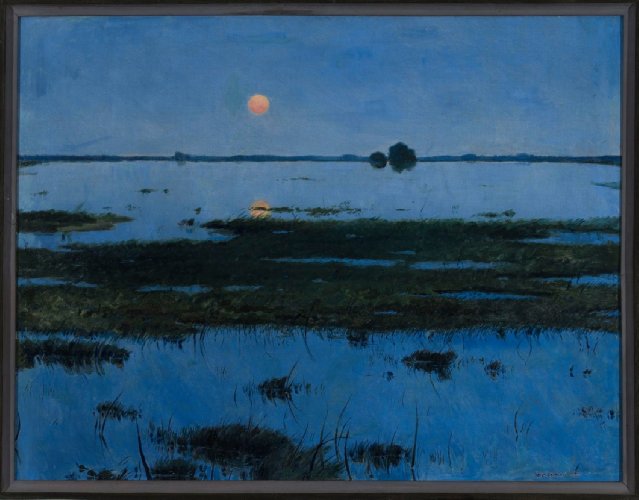Description:
Swamps and the large gallery of Zagony presented by the artist are the quintessence of his creativity, repeatedly displaying the unadorned views of boundless fields, shallows, wrzosowisk and marshes. Chełmoński‘s painting, for which Rapacki is considered a successor, not only connects the way of horizontally composing pictures, but above all the contemplative attitude towards nature, resulting from its careful observation, which Wojciech Gerson encouraged in his Warsaw Drawing Class. From Munich, where he studied at Friedrich Fehr‘s private school in 1888–9, Rapacki brought a perfect technique, the ability to make a realistic and precise observation as well as to fill the pictures with moody contents, which since the 1890s take on a symbolic colouring. This can be seen in the presented Swamps, a “pure“ landscape with an unusual colouring, which emanates an all–encompassing peace.
From Munich, where he studied at Friedrich Fehr‘s private school in 1888–9, Rapacki brought with him a perfect craftsmanship, the ability to make a realistic and precise observation, and to imbue images with moody content, which since the 90s has taken on a symbolic hue. This can be seen in the presented Moczary, a “pure“ landscape of unusual colors, emanating a pervasive calm.
Józef Rapacki (1871-1929) studied at the Warsaw Drawing School, Krakow SSP and the Munich Academy. He supplemented his education with trips around Europe. He illustrated for the magazines “Tygodnik Ilustrowany“ and “Wędrowiec“. He exhibited his works multiple times in Europe and in his home country. He was part of the Warsaw group “Pro Arte“. He was a successor of the ideas of Chełmoński, called “the painter of birches and lilac heather“. He devoted most of his life to sentimental landscapes.
“Moorland Evening“ depicts a marshland, just after moonrise, which is the only warm point in the cold space, not counting its reflection in the water. The picture is kept in a narrowed color range, in which blues and navy predominate, interspersed with dark green grass among the marshes. The artist was only twenty years old when he painted this picture.
Above the vast marshes rises a orange–yellow moon, timidly reflecting in the water of the sky‘s color. There is no more evening, colorful glare of the sunset. The reflection of the sun can now only be seen on the shield of the moon. The latter is reflected in the water below. These two last warm points in the picture attract the eye amid the sea of cold blues and navy blues. The lighter shade of the sky above the horizon line reveals that it is not yet night, but late dusk. The moment when shapes around lose their colors, and the air gets colder and colder.
Description of the image:
Joseph Rapacki was known as the “painter of birches and purple heathers“. He devoted most of his life to moody landscapes. Reading his biography, one can conclude that he was a restless spirit, constantly looking for his place. He first studied in Warsaw, then in Kraków, then in Munich, then returned to Warsaw and took up paid work as an illustrator. After completing his studies, he traveled constantly throughout Europe. In 1907, he and his wife moved to Olszanka near Żyrardów on the edge of the Mariańska Forest, where he eventually settled in a house he had built himself.
This painting was painted at a very early stage of the artist‘s creative work, at that time twenty years old. It is surprising that the work painted by the young painter exudes peace and maturity. The painting is not overstated, it does not flatter with added trees, flying birds or stucco for variety. The painter seems to be telling the truth about the seen space. Most likely while painting, he had to stand in the water, immerse himself in the landscape around, feel the chill of dusk and experience the evening loneliness in the wasteland among the marshes.


